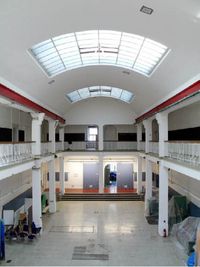Eisenbeton im Hochbau bis 1918 - Dokumentation und Analyse realisierter Bauwerke im Raum München
In the late 19th century the use of reinforced concrete achieved increasing importance. Bavaria, especially Munich was a center in development and application of reinforced concrete before 1918. Reknowned construction companies established offices there. Notable Munich engineers worked on the development of universal standards for building design, production and constuction of reinforced concrete buildings. In Munich at that time remarkable structures of historical importance emerged. First domes and early bridges were erected here. These buildings are well known, analysed in depth and documented.
Numerous buildings still exist, in which the main structural elements are reinforced concrete. They are also very important for the historical construction survey, because they were between the poles of applications for patents and the introduction of Codes of Practice and Standards. Such standards for the design and construction of reinforced concrete buildings were first introduced in Switzerland and, subsequently, in Germany. These historical buildings are usually protected by conservation orders. At the same time they are nearly unknown even to experts because the typical frame construction is in most cases covered and thus not obviously visible. In the context of central city sites usually traditional or artificial historical facades were built in style to former brick wall constructions These buildings which are important in tracing of the development of reinforced concrete constructions have not yet been adequately researched.
The thesis shall make a contribution to the construction history. The development of reinforced concrete prior to 1918 shall be reconstructed by documenting and analysing existing frame construction buildings. Their conservation status shall be checked and evaluated. Aspects like planning process and history of changes, construction details such as formwork, concrete technology and reinforcement will be considered. In addition deformations, damages and the conservation status will be established and documented.
The real execution shall be compared with the usual standards and the construction knowledge at that time. The results shall classify the general development of building technology.
The informations collected will make an active contribution to improving and implementing long term conservation of these reinforced concrete buildings.
Doctoral Thesis (2019)
Chair of Structural Design
by Joerg Rehm
